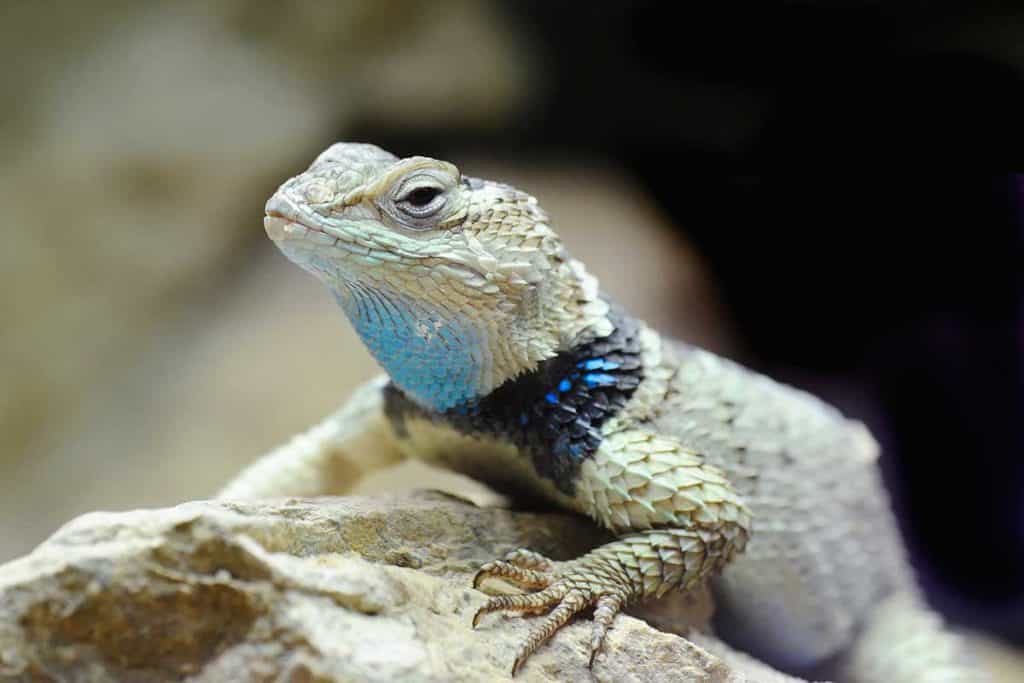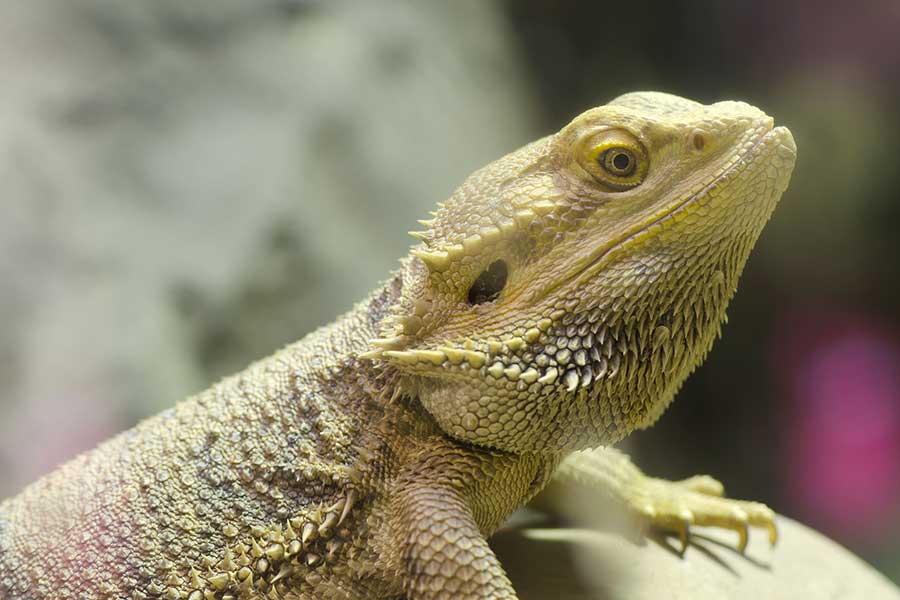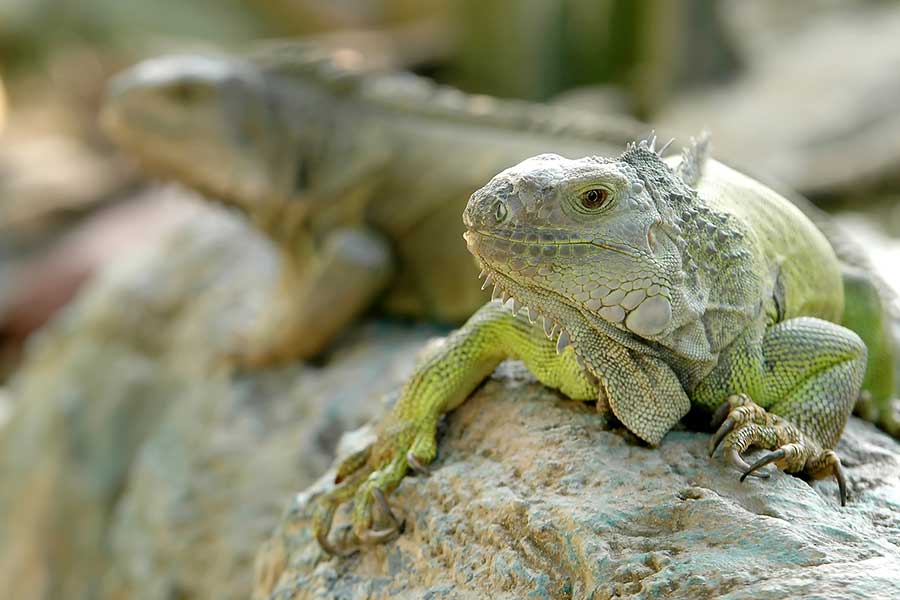It is not uncommon to see lizards, both in the wild and in captivity, bobbing their heads up and down as if they’re nodding along to music that only they can hear.
Is this normal? For most species of lizards, yes, it is! Head bobbing is a key form of communication for most lizards, and they use it in a variety of circumstances, including during mating and courtship, scaring off predators, or even just wanting a belly scratch from their owner.
In this article, we will cover the main reasons why lizards tend to bob their heads. Most are nothing to be worried about, so we’ll also talk about when you might consider this behavior unusual or a sign of health issues like stress.
We’ll also take a quick look at some of the other common lizard body language signs to look out for.
Why Do Lizards Bob Their Heads Up & Down?
There are five main reasons why lizards bob their heads up and down. They vary based on a variety of factors, such as your lizard’s species, the environment your lizard is in, and whether they are around any other lizards. Let’s go over each of them below.
Mating Rituals
When lizards come across a potential partner, they will bob their head up and down to get the attention of the other lizard and signal that they are available. This action also makes them appear attractive to their fellow lizards.
However, lizards may also do this when there are no potential partners in sight but they have that loving feeling. It can be a sign of frustration if they do not have access to an appropriate mate, especially for lizards in captivity.
Alpha Behavior
Just like people, lizards will want to attract some other lizards, but would prefer to dispel some others. If they feel like their territory is threatened, they will want to take on a commanding and dominant attitude to assert their control. Head bobbing is a behavior they engage in to show their dominance over one another, particularly male lizards.
If two lizards are in the same space and they sense conflict or threat, they will start bobbing their heads at one another in an aggressive manner.
Facing Predators
Lizards will also often bob their heads at other types of animals that might be threatening them. In this case, the behavior is a warning that they are ready to fight. This makes them seem bigger, faster, and more agile, which may help predators think twice before attacking.
This will often be accompanied by other defense mechanisms, such as expanding neck frills or displaying their dewlap.
Seeking Attention
Lizards that have grown up in captivity are accustomed to getting quite a bit of attention from their humans, and they often grow to like it. When they aren’t getting enough of it, they might bob their head to get their owners’ attention.
Social Hierarchies
Head bobbing can also be used in other forms of communication beyond mating and warding off predators. More social lizards that live in communities, for example, in the same
If you have multiple lizards, you can expect the largest, most dominant one to bob its head at the others more frequently.
When Is Head Bobbing Unusual?
While there are lots of perfectly good, natural reasons why your lizard might be bobbing its head, it can also be a sign that something is not quite right.
If they bob their head a lot, and for no apparent reason, this can be a sign that your lizard is stressed out. If you notice this, you should consider whether anything has changed in their environment that could be causing them anxiety. Perhaps, for example, they are upset by another animal’s presence in the room, like a dog or a cat or even another nearby lizard’s enclosure.
Aside from a significant change in their environment (such as the introduction of another lizard), below are the main reasons why your lizard might be stressed out, along with questions you should ask yourself to solve the issue.
- Is the temperature in their tank right? Lizards cannot regulate their body temperatures naturally, so they need the right ambient temperature to stay warm and comfortable.
- Do they have enough shelter? Lizards like to be able to curl up and hide, and if they don’t have appropriate hidey holes, they can become very stressed very quickly.
- Are they getting enough sun? Lizards need quite a lot of UVB light to produce the vitamin D3 that they need to thrive. Is the light you are using up to the job?
- Are they getting variety in their diet? It can be easy to fall into the trap of feeding your lizard the same thing every single day. But not only is this boring for your lizard; it can cause nutritional deficiencies. All lizards need variety in their diet.
- Are they getting enough
calcium ?Calcium deficiency is one of the most common problems for lizards in captivity. Are they getting enoughcalcium ? Are you giving them a suitable supplement? - Are they staying hydrated? While lizards don’t drink much water, they do need to keep hydrated. This means that they need constant access to clean water that should be changed as frequently as every day depending on how dirty it gets.
If you have checked on all of these problems and your lizard still seems to be bobbing their head in anxiety, it might be time for a trip to the vet to more accurately pinpoint the cause.
Not sure you are feeding your lizard correctly? Read our anole feeding guide here.
Other Types of Lizard Body Language
Head bobbing is a common form of lizard body language, but it is only one of the many ways they use their bodies to express themselves. Here are some of the other key lizard body language practices.
Arm Waving
This is when lizards lift one of their front feet off the ground and look like they are waving at you or another lizard.
This is a complex sign that can be either recognition of another lizard as a sign of peace, or it can be submissive because it feels threatened by the other lizard. It is also often seen in mating displays where females will signal their submissiveness or willingness to mate to nearby males.
Skin Color Changing
Some lizards are chromatophores, which means they have pigment cells that mirror light and allow them to change their body color based on their surroundings. If their skin turns black and white, this is usually a sign that they are overheating, so it might be time to turn the
They may also turn black if they feel cold in an effort to attract more warmth. Lizards like bearded dragons will also flatten their bodies like a pancake to expose as much of their skin to light and warmth as possible. If your lizard does this, it’s time to turn the heat up!
Basking
Basking is another sign of a lizard trying to warm up. They will want to spread themselves out and expose as much of their skin to the light and heat as possible.
Fluffing
When lizards that have beards (such as bearded dragons and other agamid lizards) expose them by flaring them out, this is called fluffing. This is usually a defensive behavior that suggests they feel threatened. They do this to make themselves look larger and more intimidating. It is very uncommon for lizards to fluff without being provoked.
Bowing
Female lizards will sometimes bow their heads downwards and scuttle backwards as a way of showing reverence to a dominant male. This is especially common in mating and courtship displays.
Tongue Flicking
Lizards tend to flick their tongues in and out of their mouths when they are exploring their surroundings. Taste is one of the key senses that lizards use to understand new things. In a way, they can “smell” things with their tongues!
Many lizards will lick things to better understand them. Subordinate lizards will also sometimes lick dominant lizards as a sign of submission.
Mouth Open
Lizards will sometimes keep their mouths open to regulate their body temperature, allowing heat to escape and avoid overheating. They can’t sweat like we do, so they have to adjust their body temperature in different ways. No, they aren’t just waiting for insects to fly in!
Tail Curling
If a lizard curls its tail up like a scorpion, this is generally a sign that they are alert and dominant. They might just be about to pounce on a particularly tasty bit of prey. Many lizards will also wiggle or vibrate their tails just before leaping into action to chow down on an insect or other small invertebrate.
FAQs About Lizard Behavior
What is the red thing that comes out of a lizard’s neck?
Some lizards like anoles and iguanas have a flap of skin under their chin which is called a dewlap. The size, color, and shape will depend on the species of the lizard. Many species will flare out their dewlaps in mating and dominance displays.
Why do lizards do push-ups?
Push-ups for lizards are a more energetic variation of head bobbing. They will do push-ups for a variety of reasons, including to impress a mate or to show a predator that they should not be messed with.
Head-Bobbing Demystified
While lizards can’t talk to us in words, they are actually very expressive animals when it comes to their body language. They have many distinctive displays and types of body language that are good indicators of what is going on with them, such as how they’re feeling or what they think of another nearby lizard.
Now we know why lizards bob their heads. It is one of the most common body language in lizards, which they do for a variety of reasons. They might bob their head when they meet another lizard they like and want to mate with or when they meet an aggressive lizard or other predator. Lizards in captivity might even bob their head at their owners to get some attention, a belly rub, and a tasty treat.
If you take the time to learn a bit about lizard body language, you will discover their delightful and expressive personalities.
What are your favorite lizard body language cues? Share them with the community in the comments section below.





